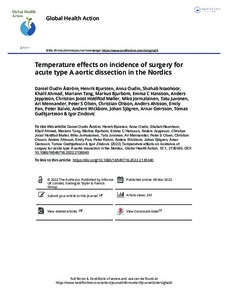Temperature effects on incidence of surgery for acute type A aortic dissection in the Nordics
Åström Daniel Oudin; Bjursten Henrik; Oudin Anna; Nozohoor Shahab; Ahmad Khalil; Tang Mariann; Bjurbom Markus; Hansson Emma C; Jeppsson Anders; Møller Christian Joost Holdflod; Jormalainen Miko; Juvonen Tatu; Mennander Ari; Olsen Peter S; Olsson Christian; Ahlsson Anders; Pan Emily; Raivio Peter; Wickbom Anders; Sjögren Johan; Geirsson Arnar; Gudbjartsson Tomas; Zindovic Igor
Temperature effects on incidence of surgery for acute type A aortic dissection in the Nordics
Åström Daniel Oudin
Bjursten Henrik
Oudin Anna
Nozohoor Shahab
Ahmad Khalil
Tang Mariann
Bjurbom Markus
Hansson Emma C
Jeppsson Anders
Møller Christian Joost Holdflod
Jormalainen Miko
Juvonen Tatu
Mennander Ari
Olsen Peter S
Olsson Christian
Ahlsson Anders
Pan Emily
Raivio Peter
Wickbom Anders
Sjögren Johan
Geirsson Arnar
Gudbjartsson Tomas
Zindovic Igor
Taylor & Francis Ltd
Julkaisun pysyvä osoite on:
https://urn.fi/URN:NBN:fi-fe2022112967681
https://urn.fi/URN:NBN:fi-fe2022112967681
Tiivistelmä
We aimed to investigate a hypothesised association between daily mean temperature and the risk of surgery for acute type A aortic dissection (ATAAD). For the period of 1 January 2005 until 31 December 2019, we collected daily data on mean temperatures and date of 2995 operations for ATAAD at 10 Nordic cities included in the Nordic Consortium for Acute Type A Aortic Dissection (NORCAAD) collaboration. Using a two-stage time-series approach, we investigated the association between hot and cold temperatures relative to the optimal temperature and the rate of ATAAD repair in the selected cities. The relative risks (RRs) of cold temperatures (<=-5 degrees C) and hot temperatures (>= 21 degrees C) compared to optimal temperature were 1.47 (95% CI: 0.72-2.99) and 1.43 (95% CI: 0.67-3.08), respectively. In line with previous studies, we observed increased risk at cold and hot temperatures. However, the observed associations were not statistically significant, thus only providing weak evidence of an association.
Kokoelmat
- Rinnakkaistallenteet [27094]
